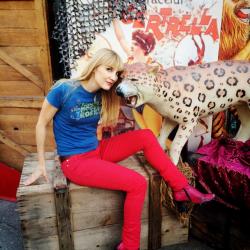It is not hard to enchant me. I am captivated quite easily by things of beauty, places of mystery, anything that calls to my heart, my soul and my imagination. And yet the spellbinding mosaic sculptures of French/American artist Niki de Saint Phalle and her final creation, Queen Califia’s Magical Circle, casts a spell so great that I can almost describe viewing it as a religious experience. Built over four years in sun-splashed Escondido, CA, about 100 miles south of Los Angeles, the artist worked on this creation right up until her death in late 2002, at age 71. It opened to the public in 2003.
Named after the mythological Amazonian Queen Califia, who was said to rule a land of golden riches, this colorful sculpture park is built with a serpentine wall, 400 feet long, on which gigantic snakes, embedded with glistening tile, uncurl their long bodies in protection of the queen at the center. A black and white tiled pathway, broken up with slivers of mirror, leads visitors on a maze-like Alice in Wonderland journey to discover a series of eight totem poles surrounding the central queen. The sculptures range from 11 to 24 feet tall and are covered with mosaic material which reflects, refracts and captures the California sunshine, constantly shape shifting in the changing light. The vibrant blue sky adds the most fitting of back drops. Emblazoned with mystical symbols, this circle is magic in its purest sense.

Queen Califia stands atop a giant eagle, which functions as a mini temple, while holding a bird in her hand. The inside of this temple is mosaiced with a starry night sky. A golden egg sits in the center (photo by Nikki Kreuzer)
Niki de Saint Phalle was born in 1930 France, but was raised through the early 1950s, in New York City. In her 20s, she married and moved back to France, with her new husband, where she soon suffered a nervous breakdown and was given electroshock treatment. She searched for salvation to her demons and found it in her commitment to making art. She aligned herself with the feminist art movement, and in the early 1960s was renowned for her gun shot paintings in which she attached colored paint canisters to her sculptures and fired ammunition at them in front of a live audience. As the canisters burst, the dripping paint created new work, and often made strong statements about society. In the 1970s she began building her first sculpture park in Tuscany and worked on it for 20 years. Influenced by the amorphous mosaic pieces of Antonio Gaudi, she finished Tarot Garden in 1998, featuring 22 large pieces all based upon the tarot card deck. In 2002, Queen Califia’s Magical Circle was the culmination of her work. She imagined her newest park in Escondido after moving to the dry air of Southern California to comfort serious lung problems brought on by the chemicals she used in her work. “California has been a rebirth for my soul and an earthquake for my eyes—sea, desert, mountains, wide open sky, brilliance of light and vastness of space,” she said after moving to La Jolla in 1994, “I have embraced another way of life, and have let my discovery of this landscape manifest itself in my work.”
Queen Califia’s Magical Circle combines de Saint Phalle’s unique folk art with a heavy dose of surrealism, creating a landscape that is at once child-like as it is full of symbolism and ancient sorcery. It is definitely a magical visit. Located within Escondido’s Kit Carson Park, it initially kept free and open daytime hours for over a decade. After suffering extensive vandalism, some of it, ironically, by bauble-collecting crows, it was forced to close for over a year between May 2013 to September 2014 while repairs were made. Now that the park has reopened, visits are restricted to supervised appointments. Open hours are now narrowed to the 2nd Saturday of each month between 10am to 2pm. It is best to call in advance to schedule a visit or to check hours before visiting.
Queen Califia’s Magical Circle: Located in the Iris Sankey Arboretum,
Kit Carson Park, 3333 Bear Valley Parkway, Escondido, CA 92025; For appointments call (760) 839-4000 or email kowens@escondido.org.











Magical! Can you come mosaic my backyard black and white during your free time?